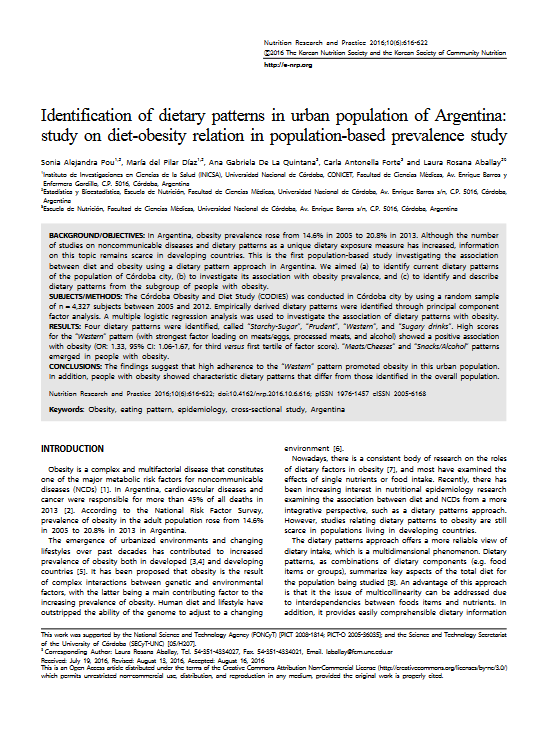Identification of dietary patterns in urban population of Argentina
Licencia: Creative Commons (by-nc-nd)
Autor(es): Pou, Sonia; [et al.]
BACKGROUND/OBJECTIVES: In Argentina, obesity prevalence rose from 14.6% in 2005 to 20.8% in 2013. Although the number of studies on noncommunicable diseases and dietary patterns as a unique dietary exposure measure has increased, information on this topic remains scarce in developing countries. This is the first population-based study investigating the association between diet and obesity using a dietary pattern approach in Argentina. We aimed (a) to identify current dietary patterns of the population of Córdoba city, (b) to investigate its association with obesity prevalence, and (c) to identify and describe dietary patterns from the subgroup of people with obesity. SUBJECTS/METHODS: The Córdoba Obesity and Diet Study (CODIES) was conducted in Córdoba city by using a random sample of n = 4,327 subjects between 2005 and 2012. Empirically derived dietary patterns were identified through principal component factor analysis. A multiple logistic regression analysis was used to investigate the association of dietary patterns with obesity. RESULTS: Four dietary patterns were identified, called "Starchy-Sugar", "Prudent", "Western", and "Sugary drinks". High scores for the "Western" pattern (with strongest factor loading on meats/eggs, processed meats, and alcohol) showed a positive association with obesity (OR: 1.33, 95% CI: 1.06-1.67, for third versus first tertile of factor score). "Meats/Cheeses" and "Snacks/Alcohol" patterns emerged in people with obesity. CONCLUSIONS: The findings suggest that high adherence to the "Western" pattern promoted obesity in this urban population. In addition, people with obesity showed characteristic dietary patterns that differ from those identified in the overall population.
[Córdoba: 2016]
Compartir:
Una vez que el usuario haya visto al menos un documento, este fragmento será visible.


